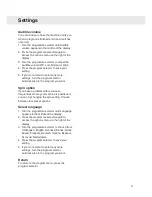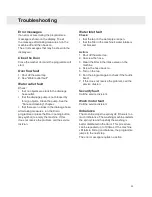
15
Washing
Programme chart
Program
Pr
e-w
ash
Temp
. °C
Number of Rinses
Spin Speed rpm
Remaining moistur
e content
[%]
Max.
load
(k
g)
W
ater consumption
(appr
ox.
liter)
Ener
gy
consumption (appr
ox.
kWh)
Pr
ogr
amme time
(appr
ox.
hrs and
min.)
1. Auto
1)
2. Stain prog
3. Time program
4. Heavy
X
90
5
1800
8
85
2,2
2:45
X
60
5
1800
8
75
1,1
2:40
5. Standard cotton
40 °C
60 °C
60
2)
3
1800
43
8/4**
55
1,10/0,83** 3:00/2:20**
40
2)
3
1800
43
8/4**
55
0,67/0,48** 2:50/2:10**
6. Everydaywash
60
3
1800
8
60
1,2
1:40
7. Quick
40
3
1800
4,0
35
0,4
0:50
8. Easy Care
40
3)
2
1200
4,0
60
0,60
1:40
9. Synthetics
40
4
800
2,5
40
0,4
1:20
10. Wool
30
3
800
2,7
70
0,5
0:50
11. Hand
30
3
800
2,7
70
0,5
0:50
12. Rinse
1
1800
4,0
15
0,1
0:20
13. Spin
1800
4,0
0,1
0:15
14. Drain
0:01
** Half load
1)
Short programme for test institutes, max. 1/2 load.
2)
Test programme for cold water connection in accordance with EN 60456. For large volumes of detergent we recommend removing the
insert and adding detergent directly to the detergent compartment.
3)
40 °C programme for test institutes. The 40 °C option must be selected.
The above table presents a few examples of the energy, water and time consumption of a few different programme settings.
Consumption can vary depending on water pressure, water hardness, water supply temperature, room temperature, load weight and
content, variations in the power supply and selected options. In the examples provided here the rinse setting is set to Normal and no
options are selected.
If you use large amounts of detergent, such as non-compact powder, and find that the amount you want to use does not fit in the
compartment, you can remove the insert and dose directly in the compartment. We recommend that all test institutes remove the
insert for large volumes of detergent.
Adjustment of the displayed washing time
Advanced technology allows the appliance to sense
the amount of laundry and add the required amount of
water during the washing process. Depending on the
washing load, washing time can be longer or shorter
and the time displayed will be adjusted accordingly.
Moreover, displayed washing time may change due
to differences in inlet water temperature. At low inlet
water temperatures, washing time can be longer; at
higher temperatures, it can be shorter.
Unevenly distributed laundry or lumps of laundry
in the washing machine drum can cause problems
such as vibration and noisy operation. The appliance
can sense such lumps and will try to redistribute the
laundry. Smaller loads (e.g. one towel, one sweater,
one bathrobe etc.) or clothes made of materials with
special geometrical properties are virtually impossible
to distribute evenly across the washing machine drum
(slippers, large items etc.). This results in several
attempts to redistribute the laundry, which in turn
leads to longer program duration.
















































